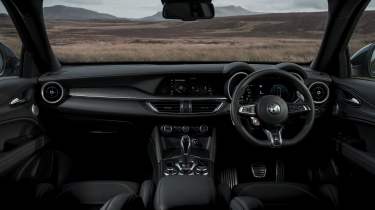Alfa Romeo Stelvio Quadrifoglio – interior and tech
The interior isn't the Stelvio’s strongest asset, but the basics are there, and it does still feel special
It’s fair to say that the interior struggles to warrant the Quadrifoglio’s £80k+ price tag in terms of its subjective feel and dated appearance in some areas.
Standard equipment is substantial and the basics are right, such as the firm, bolstered seats (although it took this tester a while to establish a comfortable driving position), well-shaped and nicely trimmed steering wheel and wonderfully tactile aluminium paddles behind, but the overall interior is not up to the high standards seen in rivals such as the Porsche Macan.
> Italy bans Alfa Romeo Milano name, so now it’s Alfa Romeo Junior
Post-2024 cars get a three-dimensional carbonfibre finish throughout much of the interior as standard, which is an acquired taste. They also get a new configurable digital TFT screen for the instrument panel ahead of the wheel, within the traditional dashboard cowling. It takes a little while to learn the best combination of graphics and to navigate through the different displays until you become familiar with it, but it’s an up-to-date set-up that helps to keep the Stelvio cabin feeling contemporary.
Something that to some testers feels slightly compromised is the seating position, which like in many SUVs with saloon car origins, cants the driver forward ever so slightly. It’s as if the steering wheel doesn’t so much level out in front of you as rise from somewhere lower beneath your feet. If you’ve driven a Volkswagen Tiguan, you’ll know what we mean.
Interior space is otherwise good, sitting somewhere between that of an Audi Q3 and Q5, and the boot is certainly more than big enough to cope with an evo photographer’s gear as Aston Parrott found out after running one as a long-term test car.


